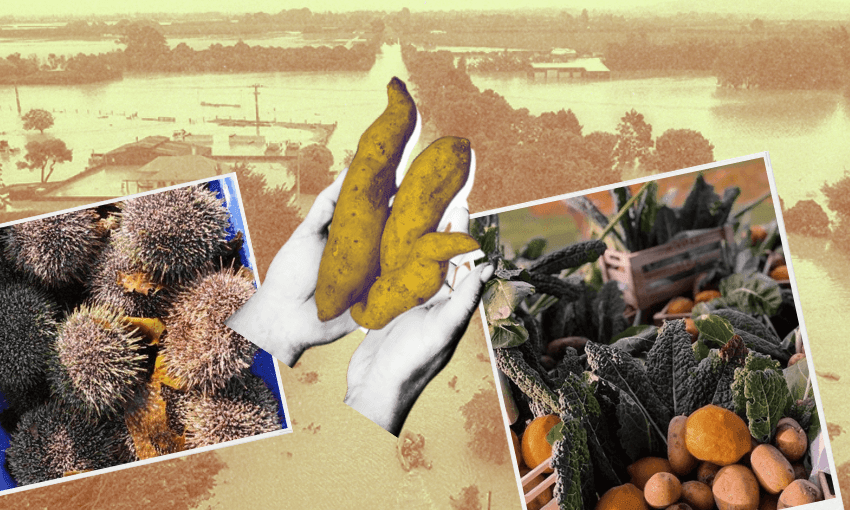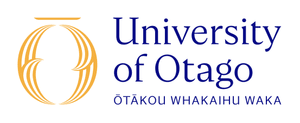Reclaiming the relationship between people and their local kai is central to the concept of kai sovereignty. But what happens when a major weather event wipes out much of a region’s food production? Two University of Otago researchers plan to find out.
In 2023, Cyclones Hale and Gabrielle caused ecological crises in Te Tai Rāwhiti. Ecosystems were destroyed, and many whānau and communities were cut off from supermarkets and unable to harvest or gather kai. Excessive rain and flooding triggered a wider ecological catastrophe. Pine forestry slash washed down hillsides, overwhelmed local rivers, destroyed bridges, smothered farms and covered beaches.
This was accompanied by inland erosion and tonnes of silt washing down rivers and into the coastal marine environment, impacting marine mahinga kai. At the same time, landslides blocked roads and cut entire communities off.
As with Cyclone Bola in 1988, the unpreparedness of local emergency services, systems and local government to restore infrastructure left many whānau and communities facing the uncertainty of isolation. The inability to access food from local supermarkets, let alone gather wild kai or harvest crops, meant many whānau living in Te Tai Rāwhiti were disconnected from their local kai systems for an uncertain period of time.
This was the launchpad for new research led by Dr Kenneth Taiapa (Ngāti Porou, Te Whānau ā Apanui, Rongowhakaata) and Dr Christina McKerchar (Ngāti Porou, Ngāti Kahungunu, Tūhoe) from Climate Health Aotearoa (CHA) at the University of Otago. Through this lens, their research aims to explore the mental health impacts of climate change on kai sovereignty.
The project connects these two researchers to their turangawaewae in Te Tai Rāwhiti through community-based research grounded in wānanga and supporting the development of local researchers. The goal is to explore food sovereignty and mental health within communities along State Highway 35 in Te Tai Rāwhiti.
Extreme weather events like Cyclone Gabrielle, which affected these Te Tai Rāwhiti communities, highlight the importance of kai sovereignty as a protective factor against some of the impacts of climate change.
In Te Mahi Māra Hua Parakore: A Māori Food Sovereignty Handbook, Jessica Hutchings defines Māori food sovereignty as “the practice of ensuring food-secure futures for whānau, independent of multinational and national food systems and in harmony with Te Ao Tūroa (the natural world)”.
Taiapa agrees with that definition. He says “it’s about regaining control over our kai and kai systems and relationships to kai”, which go beyond plastic-wrapped food in the supermarket aisle. The focus is on reconnecting to a legacy of growing and gathering kai from mārakai and other mahinga kai sources.
McKerchar says food sovereignty is about reclaiming a positive relationship with the kai we eat. “Kai has a whakapapa, and it’s about how we relate to that whakapapa.”
She recently led a series of focus groups which highlighted differences in how Māori and non-Māori think of sustainable food. The Māori-specific groups often related kai to the atua Māori, such as Haumia-tiketike, the atua of uncultivated food; Rongo-mā-Tāne the atua of kūmara and cultivated food; and Tangaroa, atua of the sea and fish.
Taiapa reckons many other te ao Māori concepts have a relationship with kai sovereignty. “Aroha, manaakitanga, mana, whanaungatanga; they all speak to different parts of our relationships to food and our mahi kai and mara kai.”
Kai sovereignty is also about healing. For his PhD, Taiapa worked with Ngāti Tāwhirikura hapū in New Plymouth as they reconnected to their tūrangawaewae through a mārakai initiative after a challenging treaty settlement process.
“Reconnecting back to their whenua by growing kai in the domain of Rongo-mā-Tāne was a healing process for them,” says Taiapa.
The strengthening of self-identity can be a prized part of kai sovereignty, says McKerchar. The ability to gather kai in the rohe of one’s iwi or hapū is highly valuable, with different communities often priding themselves on their food-gathering practices. The practices of whānau related to the gathering of tītī muttonbirds in the small islands around Rakiura Stewart Island are a good example of this.
So what does kai sovereignty look like for us here in Aotearoa? Taiapa says that it means whānau reconnecting to papakāinga and whenua, and working together to share knowledge, tools, and other resources to grow and gather their kai.
In practice, it means things like food forests and māra in urban marae and kōhanga reo, and commercial kitchens that cook for people in emergency housing, marae and whānau-led projects. On a grander scale are kai-focused enterprises like the Whakatū Nelson-based Wakatū Incorporation and its ambitious 500-year intergenerational plan.
These kaupapa all have one thing in common: they are a pathway to increasing ownership and control over kai systems for local communities and reconnecting people with kai.
Kai growing and gathering practices are affected both by the slow-moving adjustments in rainfall and temperature caused by climate change, and the immediate impacts of weather events like flooding and cyclones. “You aren’t able to rely on what you’ve previously relied on,” says McKerchar. “With Cyclone Gabrielle, diving and land use changed as sediment washed into the waterways and tree logs smashed the crayfish.”
Natural disasters like cyclones can destroy ecosystems and habitats used for generations by local communities, further reducing their access to kai. In the case of Te Tai Rāwhiti, this was much worse for some whānau who were also cut off from local towns and unable to buy food for long periods of time.
Anxiety, stress and despair are among the well-known psychological effects of serious weather events like Cyclone Gabrielle. For whānau, there’s also an impact on their community’s ability to maintain sovereignty over their kai systems and mana motuhake over the whenua that sustains them. As McKerchar puts it, “Your kai sources are wiped off the face of the whenua.” The land just irrevocably changed around you.
The truth is we don’t know enough about the mental health effects of an event like Cyclone Gabrielle, and the ensuing isolation of affected communities like those in Te Tai Rāwhiti. “If the river is going to flood, the coast is eroding, communities are cut off, habitats are washed out, and ecosystems are overloaded,” says Taiapa, “what kind of anxiety is that causing our whānau in stress and mental load?”
Taiapa and McKerchar are determined to explore the impacts of extreme weather events, and climate change more generally, on kai sovereignty. They’ve been awarded a three-year grant from the Health Research Council to study the issue, which they say has been under-researched in Aotearoa. Ōtepoti Dunedin is a long way from Te Tai Rāwhiti Gisborne, where both researchers have deep roots, so they have relied on East Coast whānau Tui Warmenhoven, Chris Haenga, Wiremu Reihana and Ron Taiapa, along with support from the Eastern Institute of Technology and Te Tima Taiao at Te Runanganui o Ngāti Porou, to help them with the groundwork for the project.
The pair agree that the real expertise is in the community, and they have designed the research accordingly. Whānau will be trained, employed and supported as community researchers to conduct interviews in their communities, particularly those affected by Cyclone Gabrielle, to explore the mental health impacts of climate change on kai sovereignty. Taiapa and McKerchar will then run wānanga to analyse the data and establish findings with the community researchers.
Other researchers will be trained in using PhotoVoice, a participatory research method that combines photographs and narratives to support social change. The researchers will photograph kai sovereignty initiatives in their communities to show what healing and recovery from the cyclones look like on the ground.
“Taking photos has much more of an impact than writing. We’ll work with these communities to develop critical dialogue, show the images and share the korero from whānau,” says Taiapa. Community researchers and the wider research team will present the findings at hui in each community. At the end, a Te Tai Rāwhiti-wide hui will be held, where community researchers will share their findings alongside the rest of the team.
The research will begin with a community-wide hui followed by trips up and down SH 35, connecting, having kai, and increasing community awareness of the project. The researchers say they’re excited to take their mahi back home.
For Taiapa, commencing this research marks the end of a long journey starting decades ago at Ngata Memorial College in Ruatoria, where he went to school. “Community leaders like Selwyn Parata, Parekura Horomia, and Apryll Parata all used to tell us to go away and get the skills and come back when we are ready. I think we’re hitting that phase. We’ve been away long enough.”

